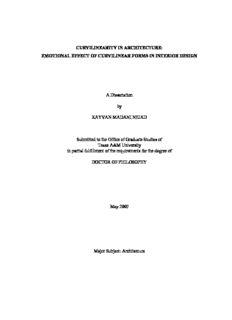
etd-tamu-2007A-ARCH-Madani PDF
Preview etd-tamu-2007A-ARCH-Madani
CURVILINEARITY IN ARCHITECTURE: EMOTIONAL EFFECT OF CURVILINEAR FORMS IN INTERIOR DESIGN A Dissertation by KAYVAN MADANI NEJAD Submitted to the Office of Graduate Studies of Texas A&M University in partial fulfillment of the requirements for the degree of DOCTOR OF PHILOSOPHY May 2007 Major Subject: Architecture ii CURVILINEARITY IN ARCHITECTURE: EMOTIONAL EFFECT OF CURVILINEAR FORMS IN INTERIOR DESIGN A Dissertation by KAYVAN MADANI NEJAD Submitted to the Office of Graduate Studies of Texas A&M University in partial fulfillment of the requirements for the degree of DOCTOR OF PHILOSOPHY Approved by: Co-Chairs of Committee, Mardelle M. Shepley Andrew D. Seidel Committee Members, Yvonna S. Lincoln Roger S. Ulrich Head of Department, Mark J. Clayton May 2007 Major Subject: Architecture iii ABSTRACT Curvilinearity in Architecture: Emotional Effect of Curvilinear Forms in Interior Design. (May 2007) Kayvan Madani Nejad, M.S., I.A. University of Tehran Co-Chairs of Advisory Committee: Dr. Mardelle Shepley Dr. Andrew Seidel People are becoming more aware of the relationships between the built environment and their physical and psychological well-being. This has encouraged numerous studies in the field of environment and behavior, and effects of architecture, urban design and architectural form on human response. In the realm of architectural form, some professionals, from "signature" architects to environmental and organic designers, are strong advocates of free-flowing curvilinear forms. They assume that the use of curvilinear forms is sympathetic to the body, mind and spirit, although there is little empirical research to confirm this claim. There is also little research on the topic of signature / star architects and their design methods. The purpose of this multi-method study was to investigate the emotional effects of curvilinear forms in interior architectural settings. The research involved qualitative and quantitative methodologies. In the qualitative phase, twelve signature architects, known for their use of curvilinear forms, were interviewed to examine the reasons and processes by which they applied curvature in their work. They were also asked to talk about their design process. In the quantitative phase, two modified interior residential views were ranked on their emotional load by 230 non-architect and 75 architect iv students in card-sorting tasks. In each view, architectural forms gradually changed from fully rectilinear to fully curvilinear. The data from both phases of the research was analyzed. The dissertation concludes by discussing (a) factors that separate signature architects from others (b) how signature architects design (c) how and why designers utilize curvature in the built environment, and (d) different emotional responses of designers and non-designers in response to curvature in architectural settings. In general, quantitative data indicates that non-architects show significant positive response to curvilinear architectural forms. Non- architects found curvilinear forms to be pleasant, elevating and reducing stress. The strongest relationship was recorded between curvature and feminine qualities of architectural space, which was shared by both architects and non-architects. v DEDICATION “M” vi ACKNOWLEDGMENTS I would like to thank ray, Mardelle and Dean Regan for their unconditional support. I couldn’t have done this thing without your help. vii TABLE OF CONTENTS Page ABSTRACT................................................................................................................iii DEDICATION.............................................................................................................v ACKNOWLEDGMENTS...........................................................................................vi TABLE OF CONTENTS............................................................................................vii LIST OF FIGURES.....................................................................................................xi LIST OF TABLES.....................................................................................................xv CHAPTER I INTRODUCTION.....................................................................................1 1.1 Need for Research on Architectural Form....................................................2 1.1.1 Rectilinear and Curvilinear Architectural Forms.......................4 1.2 Need for Research on Differences on Architects and Non-Architects..........5 1.3 Need for Research on Signature Architects and Their Design Process.........6 1.4 Objectives and Questions............................................................................7 1.4.1 Quantitative Objectives.................................................................7 1.4.2 Qualitative Questions....................................................................9 1.5 Plan of the Dissertation.............................................................................11 II LITERATURE REVIEW AND THEORETICAL FOUNDATION...........12 2.1 Architects & Non-Architects.....................................................................12 2.2 Research Related to Design Aesthetics......................................................15 2.2.1 Research in Psychology..............................................................17 2.2.2 Research in Environmental Behavior and Design........................18 2.2.3 Theories in Organic Architecture................................................21 2.3 Architectural Design Process.....................................................................22 2.4 Architectural Design Review.....................................................................26 2.5 Summary...................................................................................................28 III QUANTITATIVE METHODOLOGY........................................................30 3.1 Overview of Study Design........................................................................30 3.2 Design of Sample Views...........................................................................31 viii CHAPTER Page 3.3 Selecting Subjects.....................................................................................35 3.4 Selecting Variables....................................................................................37 3.5 Obtaining Visual Ratings..........................................................................39 3.6 Data Collection Procedure.........................................................................41 IV QUANTITATIVE DATA ANALYSIS AND RESULTS............................44 4.1 Overview of Analysis Procedure...............................................................44 4.2 Tools and Methods for Determining Relationships Between Variables......45 4.2.1 Data Organization.......................................................................46 4.2.2 Descriptive Statistics...................................................................47 4.2.3 Univariate Analysis of Variance (ANOVA)................................47 4.2.4 Pearson Correlation....................................................................48 4.2.5 Multiple Regression....................................................................48 4.3 Description of the Respondents................................................................49 4.3.1 Age.............................................................................................49 4.3.2 Gender........................................................................................51 4.3.3 Ethnicity.....................................................................................52 4.3.4 Academic Major.........................................................................53 4.4 Correlation Between Variables.................................................................54 4.4.1 Non-Architects...........................................................................56 4.4.2 Architects...................................................................................57 4.5 Results of Relationships Between Curvature and Emotional Variables.....58 4.5.1 Unpleasant – Pleasant.................................................................58 4.5.2 Depressing – Elevating...............................................................68 4.5.3 Stressful – Relaxing....................................................................76 4.5.4 Unfriendly –Friendly..................................................................84 4.5.5 Impersonal – Personal.................................................................92 4.5.6 Unsafe – Safe............................................................................100 4.5.7 Simple – Complex ...................................................................108 4.5.8 Not Mysterious – Mysterious....................................................116 4.5.9 Masculine – Feminine...............................................................124 4.6 Emotional Variables as Predicators Using Multiple Regression...............136 4.6.1 Pleasantness ............................................................................136 4.6.2 Privacy.....................................................................................136 4.6.3 Safety.......................................................................................136 4.7 Summary of the Results..........................................................................137 V QUALITATIVE METHODOLOGY............................................................139 5.1 The Researcher........................................................................................139 5.2 Theoretical Paradigm..............................................................................141 5.3 Research Design......................................................................................144 5.4 Data Collection.......................................................................................148 ix CHAPTER Page 5.5 Data Analysis..........................................................................................151 5.6 Trustworthiness.......................................................................................154 VI QUALITATIVE DATA ANALYSIS..........................................................156 6.1 History of the Architects.........................................................................156 6.2 Stars........................................................................................................159 6.3 Links to Architectural Theory..................................................................163 6.4 Myth and Meaning..................................................................................166 6.5 Architect or Artist: The Relationship Between Art and Architecture........168 6.6 Architects and Their Design Process.......................................................173 6.6.1 Physical Models........................................................................173 6.6.2 Design State of Mind................................................................175 6.6.3 Site, Environment and Landscape.............................................176 6.6.4 Materials and Methods in Design..............................................177 6.6.5 Concept and Idea......................................................................178 6.6.6 Teaching Design.......................................................................180 6.6.7 A Different Style?.....................................................................181 6.7 The Role of Nature..................................................................................182 6.8 Cost and Budget......................................................................................184 6.9 Architects and Non-Architects.................................................................186 6.9.1 The Role of Architectural Education in Perception of Built Environment.............................................................................186 6.9.2 Architect / Client Relationship..................................................187 6.9.3 How Do Non-Architects Respond to Built Environment? .........188 6.9.4 Do Architects Respond Differently?.........................................190 6.9.5 Architect’s Agenda...................................................................192 6.9.6 Choice in Selecting Architects..................................................193 6.10 Environmental Research and Architectural Form..................................195 6.11 Architect’s Use of Curvilinear Forms...................................................197 6.11.1 Uniqueness.............................................................................197 6.11.2 Ancient Cultures.....................................................................198 6.11.3 Curves and Function...............................................................199 6.11.4 Psychological Quality of Curvilinear Form.............................201 6.11.5 Intuition..................................................................................202 6.11.6 Technology.............................................................................203 6.12 Case Specific Responses......................................................................204 6.13 Architects’ Concern With Research Question.......................................206 VII INTERPRETATION.............................................................................208 7.1 Differences Between Architects and Non-Architects...............................209 7.2 Signature Architects and Their Design Process........................................212 x CHAPTER Page 7.3 Affects of Curvilinear Architectural Form on People’s Response to the Built Environment...................................................................................216 7.4 Summary.................................................................................................220 VIII CONCLUSION.....................................................................................221 8.1 Recommendations for Further Research.................................................221 8.2 Limitations.............................................................................................222 REFERENCES.........................................................................................................226 APPENDICES..........................................................................................................236 VITA........................................................................................................................257
Description: